 Range Rover: Electric parking brake (EPB)
Range Rover: Electric parking brake (EPB)
![]() WARNING
WARNING
Do not rely on the parking brake to hold the vehicle stationary if the brake warning lamp is illuminated or the EPB warning lamp is flashing. Seek qualified assistance urgently.
![]() NOTICE
NOTICE
The parking brakes operate on the rear wheels. Therefore, secure parking of the vehicle is dependent on being on a hard and stable surface.
![]() NOTICE
NOTICE
Do not rely on the parking brake to operate effectively, if the rear wheels have been immersed in mud or water.
Note: If the vehicle is used in severe off-road conditions (e.g. wading, deep mud, etc.), additional maintenance and adjustment of the parking brake will be required. Consult your Land Rover Retailer/Authorized Repairer.

With the ignition turned on, press the brake pedal and press down on the EPB switch. This will release the electronic parking brake.
With the vehicle stationary, pull up the switch and release it to apply the parking brake.
The parking brake warning lamp will illuminate. It is important to confirm that the lamp is continuously illuminated (not flashing), as this indicates the brake has been correctly applied. See 57, WARNING LAMPS AND INDICATORS.
If the lever is operated when the vehicle speed is less than 2 mph (3 km/h) the vehicle will be brought to an abrupt stop. The stop lamps will not be illuminated.
The EPB will be applied automatically if the ignition is switched off and the vehicle speed is below 2 mph (3 km/h), unless P (Park) is selected. To prevent automatic operation, when the vehicle is stationary, press and hold the EPB switch in the release position. Within 5 seconds, switch off the ignition and continue to hold the EPB switch for a further 2 seconds.
![]() NOTICE
NOTICE
Driving the vehicle with the parking brake applied, or repeated use of the parking brake to slow the vehicle, may cause serious damage to the brake system.
In an emergency, with the vehicle traveling more than 2 mph (3 km/h), pulling on the EPB switch and holding gives a gradual reduction in the speed. The brake warning lamp will illuminate accompanied by a warning tone and CAUTION PARKBRAKE APPLIED appearing in the message center. The stop lamps will illuminate.
If the vehicle is stationary with the EPB applied and the transmission in D or R, pressing the accelerator will release the EPB and allow the vehicle to move off.
Note: Automatic release of the EPB is only possible when the driver’s door is closed or the driver’s seat belt is buckled.
The parking brake system gradually reduces the system load to assist a smooth drive away. If the reduction in system load causes the vehicle to move after a valid gear is selected, full load will be automatically re-applied to the parking brake. To override the load reducing feature of the EPB, manually apply the parking brake after selecting a gear.
In the event of a failure, the message PARKBRAKE AUTO RELEASE UNAVAILABLE will be displayed in the message center.
At the start of a journey, EPB release times may be extended when changing from P or N. This is to allow for increased gear engagement times.
If the system detects a fault with the EPB, the amber brake warning lamp will illuminate accompanied by a message on the message center.
If the system detects a fault while EPB is operating, the red parking brake warning lamp will flash and the message PARKBRAKE FAULT will appear in the message center.
Note: The red parking brake warning lamp will continue to be illuminated for at least ten seconds after the ignition has been turned off.
 Electronic brake force distribution (EBD)
Electronic brake force distribution (EBD)
EBD controls the balance of braking forces supplied to the front and rear wheels,
in order to maintain maximum braking efficiency.
If the vehicle has a light load (only the driver in the vehicle fo ...
See also:
Charging the batter
WARNING
Never charge a battery still installed in the
vehicle unless a battery charger unit approved
by Mercedes-Benz is being used. Gases may
escape during charging and cause explosio ...
Tire Sealant and Compressor Kit
WARNING
Idling a vehicle in an enclosed area with poor ventilation is dangerous. Engine
exhaust may enter the vehicle. Engine exhaust contains carbon monoxide (CO) which
cannot be seen or smell ...
Roadside Service (Mexico)
As a new owner, your vehicle is automatically enrolled in the Roadside Assistance
program. The services are available at no cost under the terms and conditions of
the program. The Roadside Assistanc ...







